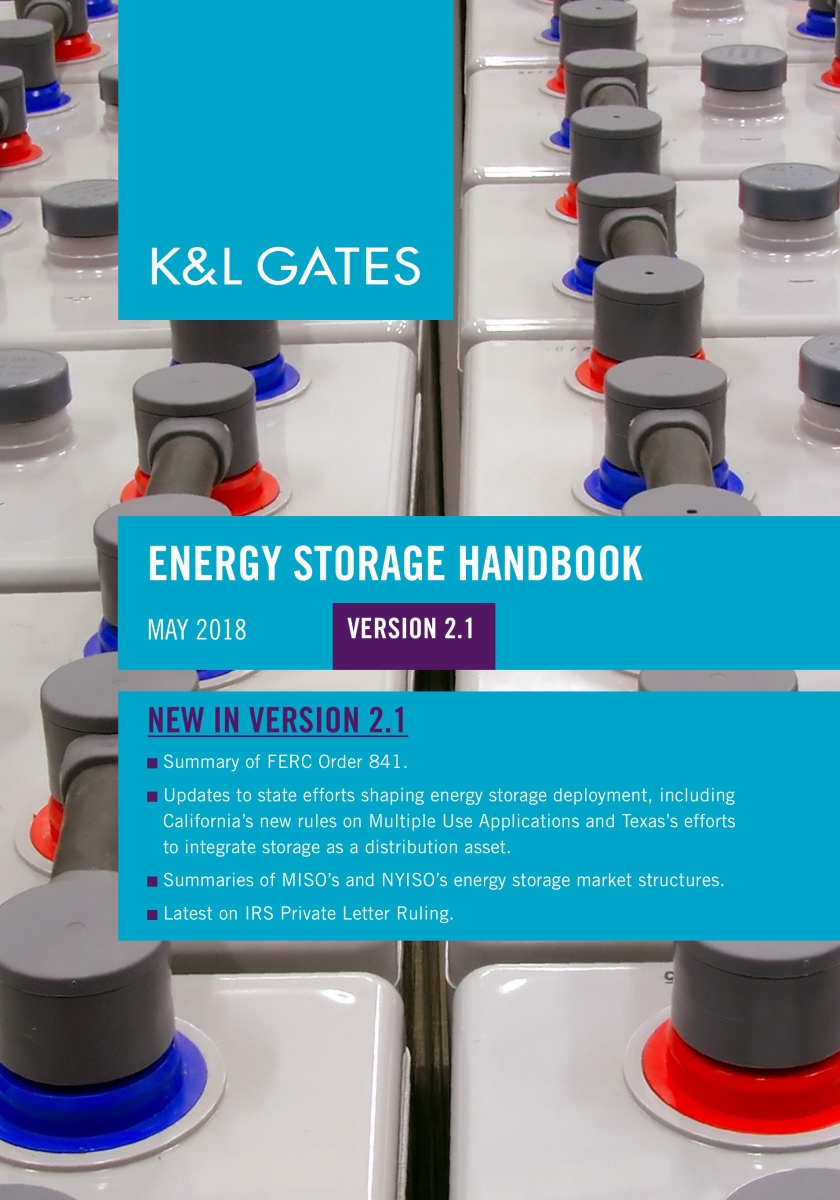There’s no doubt that today’s energy storage market is thriving, and only continuing to grow. Better policies are being put in place to help storage make sense and continuing education is encouraging more consumers than ever to consider a solar and energy storage system. Over the past year, storage deployments were up 232%, according to the latest Q2 Energy Storage Report published by Wood Mackenzie Power & Renewables. The report also highlights more specifically the major growth in behind-the-meter (BTM) storage, which made up 60% of the total deployments for Q1 in 2019. That number is up 40 percent from the previous quarter, which can be attributed in part to major storage incentives programs like SGIP.
Things are good, deployment numbers are up significantly, but there are still a lot of challenges that the market is facing, especially in the BTM sector. K&L Gates, an international esteemed law firm just recently published its 4th version of the Energy Storage Handbook which overviews a number of current regulatory and development issues facing project developers in today’s market. We overviewed in-depth all the hurdles in a webinar co-hosted by the K&L Gates team and contributors to the Energy Storage Handbook, which you can watch here. We’ve also recapped each section below. Panelists from the webinar include Elizabeth Crouse, partner at K&L Gates specializing in Tax, Buck Endemann, the editor of the handbook and partner and K&L Gates and Jim Wrathall, counsel with K&L Gates.
Energy storage federal & state tax incentives
Federal and state and incentives are probably among the biggest questions being asked in regard to energy storage. State incentives will vary from state to state; as a developer, it’s important to be clear on those incentives and what they can achieve. When developers are deciding to put in a storage system, particularly outside of California where the incentives are much clearer, they should spend a good amount of time researching how to make them work for investors.
Currently, there are two types of federal tax credits in play; the federal Investment Tax Credit (ITC) and the Modified Accelerated Cost Recovery System (MACRS). MACRS may apply to energy storage systems depending on who it is owned by. If the system is owned by a private party, the battery is eligible for some or all of the inventive. If it is a publicly owned project, like a government agency or public school, the systems are not eligible.
Both commercial and residential projects are eligible for the ITC. If you are installing an energy storage system on a commercial property, it’s eligible as long as the battery is charged by a renewable energy system, like solar, more than 75 percent of the time. If you are installing an energy storage system on a residential property, the only way it will be eligible for a credit under the ITC is if the battery is only charged by the on-site solar system. Keep in mind that 2019 is the last year to take advantage of the full 30 percent value of ITC before it incrementally steps down to 10 percent in 2022 for commercial projects. The ITC will be completely phased out for residential installations for homeowners in 2022. Right now, there is a bill in both the House and the Senate that would extend the ITC to standalone energy storage. It would authorize the credit for storage under a similar timeline to what is now in place for solar where the money will decrease over the years. Although there is a lot of support for this bill, it still may not go anywhere.
Self Generation Incentive Program (SGIP) in ETB
While the ITC for solar is among the biggest storage incentives for most projects, there are other options that can help reduce energy storage costs like SGIP. Energy Toolbase can accurately model all energy storage projects, hybrid or standalone, along with modeling SGIP (we recently updated our SGIP incentives in the platform, check out our recent blog post). We’ve made it our goal to streamline these incentive programs and make it easier and more intuitive to include them directly into project workflow. Once the incentive level a project is coming in at is selected, ETB does all the legwork on the back-end to calculate the SGIP incentive based on different parameters of a project. Here is the most up-to-date status of the current SGIP budget.
In May of 2019, the California Public Utilities Commission (CPUC) released a proposed decision for greenhouse gas reduction requirements for the SGIP budget. The proposed decision is close to getting finalized with the target date of implementation of April 2020. There are some changes for both the residential and commercial sector to be aware of. Commercial requirements would include:
- Penalties for projects not reducing greenhouse gases (5kg/kWh)
- PBI for all new projects
- Cycling requirements reduced to 104/year
- Fleet level reporting requirements
Residential requirements include:
- Customers required to be on a TOU “storage rate”
- No cycling requirements
- Fleet level reporting requirements (6/months)
Incentives are always changing and we expect to see more behind-the-meter storage programs continuing to be rolled out in different states. Energy Toolbase will continue to work to provide the most accurate and transparent incentives within the platform.
Federal regulatory updates for storage
When battery costs began to decline a few years ago, that was when there was a serious recognition that storage could be a realistic solution for the renewable market. During that time it also became clear that changes in the market needed to be made to successfully integrate storage resources. That’s when FERC Order 841 was introduced saying if capable, storage can participate in energy capacity and ancillary services, but market operators must:
- Have a minimum size requirement of 100 kW
- Account for physical and operational characteristics through the bidding process
- Ensure that storage resources can be dispatched and can set the wholesale market clearing price as a buyer/seller
FERC Order 845 was also introduced which is about adjusting the market to accommodate energy storage and interconnection. This order made significant strides in providing parties with a bit more certainty. The biggest takeaway from all this was that it is now much easier for developers to pair storage with renewable assets. Storage can be located at the same site as solar for a minimum increase and cost and includes more efficient procedures for changing technology. These updates also allowed for provisional interconnection service and allow facilities to connect at less than the facility’s total capacity.
Energy storage development hurdles
There are still hurdles to overcome despite programs, policies, and incentives that are put in place to ease the transition for storage. Some of those include new and evolving business models, consistency among site host agreements, fire code and zoning and lining up incentives. Having a good understanding of what money is coming in and when is something to take into consideration with storage. For example, with SGIP, sometimes the money will all come upfront, and sometimes it comes in gradually. Other things to think about are EPC and supply agreements; you’ll want to match your battery with your warranty and how your battery is expected to perform. Be thinking about battery supply agreements, will there be delivery associated with the battery? And of course, counterparty risk. Will the utility remain creditworthy? These are all additional development issues associated with energy storage.
Financing and monetizing storage projects
At the rate energy storage is growing, it is going to require a lot of money. With sourcing new money for storage, there are new, additional challenges for financing and monetizing projects, just as there is with development. Investors are now finally comfortable with solar, but they aren’t as comfortable with storage for a variety of reasons. With storage, there are often no contracted long term sources of revenue, such as with a power-purchase agreement (PPA), and optimizing operations require active management supported by sophisticated software. One of the most significant challenges is the shorter track record to understand and hedge the technology risk for investors.
The keys to having success in financing and monetizing projects with the complexities that energy storage brings in simply goes back to the basics. Having clarity and certainty in your revenue streams, reliable system performance and dispatch, Energy Toolbase has integrations with Stem and AMS, two world leaders in energy storage performance simulation platforms. It also comes down to increased participation by large corporates who are confident in the success of energy storage. Financial models for energy storage projects get structured several different ways and Energy Toolbase is able to create any transaction template that is needed for a project.
See the full webinar recording here:


